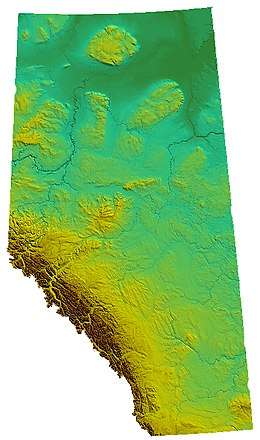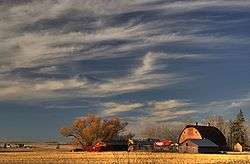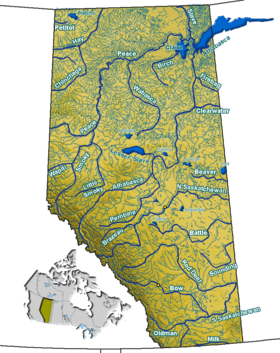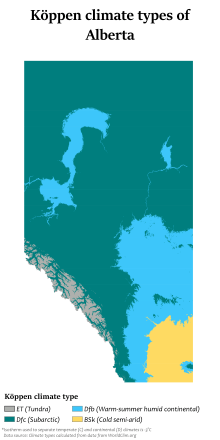Geography of Alberta
Alberta is a Canadian province. Located in Western Canada, the province has an area of 661,190 square kilometres (255,290 sq mi) and is bounded to the south by the U.S. state of Montana along 49° north for 298 kilometres (185 mi); to the east at 110° west by the province of Saskatchewan for 1,223 kilometres (760 mi); and at 60° north the Northwest Territories for 644 kilometres (400 mi). The southern half of the province borders British Columbia along the Continental Divide of the Americas on the peaks of the Rocky Mountains, while the northern half borders British Columbia along the 120th meridian west. It is one of only two landlocked provinces (Saskatchewan is the other).
 | |
| Continent | North America |
|---|---|
| Region | Western Canada Canadian Prairies |
| Coordinates | 49°00′00″N 114°04′09″W -- 60°00′N 110°00′W |
| Area | Ranked 6th among provinces |
| • Total | 661,848 km2 (255,541 sq mi) |
| • Land | 97.05% |
| • Water | 2.95% |
| Coastline | 0 km (0 mi) |
| Borders | Total land borders: U.S. states Montana; Canadian provinces British Columbia, Saskatchewan and Northwest Territories |
| Highest point | Mount Columbia 3,747 metres (12,293 ft) |
| Lowest point | Slave River 210 metres (690 ft) |
| Longest river | Athabasca River 1,231 kilometres (765 mi) |
| Largest lake | Lake Athabasca 2,295 kilometres (1,426 mi) |
Terrain

Alberta is a fertile province, as the southern portion of its surface consists chiefly of plains that are almost entirely treeless. As the slopes of the Rocky Mountains to the west are reached, more trees are found until in the foothills of the mountains, bodies of forest timber occur. Trees also become more numerous in the northern part of the province, until in the region north of the North Saskatchewan River continuous forests are met with again. From the southern boundary line for 2.5° north the prairie is dry, but of good soil, which grows excellent crops when irrigated. North of this region, the surface of the province is of the most fertile soil, with ordinary rainfall sufficing for agriculture. Alberta also has large oil reserves, especially in the Athabasca Oil Sands in the north of the province.
The appearance of the prairie section of the province is that of undulating grasslands, with rounded sloping ridges covered with shorter grasses, which serve for the support of large herds of beef cattle. The wooded portions of the terrain are dotted with clumps and belts of trees of moderate size, giving them a park-like appearance. In winter it is generally very cold, but this is occasionally reduced by a warm wind from the west, known as the Chinook.
A Geological Survey of Canada map published in 1970 shows the following physiographic regions to be present at least partially within Alberta:[1]
- Interior Plains
- Great Slave Plain
- Alberta Plateau
- Fort Nelson Lowland
- Peace River Lowland
- Alberta Plain
- Saskatchewan Plain
- Cypress Hills
- Cordilleran Region
- Canadian Shield
- Kazan Region
- Kazan Upland
- Athabasca Plain
- Kazan Region
Mountains
Within about one hundred kilometres (60 mi) of the mountains there is constantly in view, in clear weather, a line of snowy peaks along the western horizon. This continues for hundreds of kilometres northwestward. The Canadian Rockies are ascended by a gradual approach from the east, but are exceedingly abrupt on their transalpine slope in British Columbia. The peaks of these mountains are majestic, many of them reaching a height of more than three kilometres (1.9 mi) above the sea. Among the more notable of these are:
- Mount Columbia - 3,747 metres (12,293 ft)
- Twin Peaks massif - 3,684 metres (12,087 ft)
- Mount Alberta - 3,619 metres (11,873 ft)
- Mount Forbes - 3,612 metres (11,850 ft)
- Mount Temple - 3,543 metres (11,624 ft)
- Mount Brazeau - 3,525 metres (11,565 ft)
- Snow Dome - 3,520 metres (11,549 ft)
- Mount Lyell - 3,504 metres (11,496 ft)
- Mount Kitchener - 3,505 metres (11,499 ft)
- Mount Hungabee - 3,492 metres (11,457 ft)
Historical travelling through these mountains was difficult, and alpine passes became very important. The most noted of the Alberta passes are:
- The Crowsnest Pass, near the southern boundary line, through which a branch of the Canadian Pacific Railway runs.
- The Kicking Horse Pass, through which the main line of the Canadian Pacific Railway was built; 130 kilometres (80 mi) from the eastern end of this pass is the gate of Banff National Park, with the famous touristic town of Banff as its centre.
- The Yellowhead Pass, running west from the Athabasca River; this pass was discovered by John Palliser (1858), was crossed by Lord Milton and Dr W. B. Cheadle (1861), and by Sandford Fleming (1871–1872) in the Ocean to Ocean expedition;
The Caribou Mountains are not part of the Canadian Rockies, but are located in the northern Alberta, constituting an elevated plateau in the northern plains. They reach an altitude of 1,030 m (3,380 ft), almost 700 m (2,300 ft) higher than the surrounding area.
While not considered mountains, the Cypress Hills, located in southern Alberta, on the Saskatchewan border, constitutes the highest point between the Rocky Mountains and Labrador. They reach a maximum elevation of 1,468 m (4,816 ft), 600 m (2,000 ft) above the surrounding prairie.
Water

With the exception of the southern section, the province of Alberta may be said to be well watered. Rising from numerous valleys on the Alberta declivity of the Rocky Mountains between the international boundary line and 52° north are streams which unite to form the Oldman River, and farther north the Bow River. Running eastward these two rivers unite about 112° west, and flow on under the name of the South Saskatchewan River. North of 52° north many small streams unite to form the Red Deer River, which flowing southeastward joins the South Saskatchewan near 110° west. Between 52° and 53° north rises the great river, the North Saskatchewan. It receives a southern tributary, the Battle River, which joins it about 108° west. Pursuing their courses eastward the North and South Saskatchewan rivers unite in the Saskatchewan River (Cree, rapid-flowing river), which finds its way to Lake Winnipeg, and thence by way of Nelson River to Hudson Bay. It is one of the mightiest rivers of the continent.
At Mount Athabasca, there is an unusual occurrence where the water flows either to the Pacific Ocean on the western slope, the Arctic Ocean on the northeast, and the Atlantic Ocean on the southeast.
In the northern part of the province, between 53° and 54° north, all the waters of Alberta flow toward the Arctic Ocean. Starting at Mount Athabasca, the Athabasca River runs north and empties into Lake Athabasca near 58° north. North of 56° north flows through and from the Rocky Mountains as the Peace River. After descending northeastward to within a few miles of Lake Athabasca, it is met by a stream emerging from that lake. The united river carrying down the waters of the Athabasca slope is called the Slave River, which, passing through Great Slave Lake, emerges as the great Mackenzie River, which falls into the Arctic Ocean. Alberta thus gives rise to the two great rivers, the Saskatchewan and the Mackenzie.
While a number of fresh water, or in some cases brackish, lakes each less than 260 km² (100 mi²) in extent are situated in Alberta, two of more considerable size are found. These are Lake Athabasca, 7898 km² (3085 mi²) in extent, of which the greater part is in the province of Saskatchewan, and the other Lesser Slave Lake 1,160 km² (600 mi²) in area.
Climate


As Alberta extends for approximately 1,200 km (750 mi) from north to south, it is natural that the climate should vary considerably between parallels of 49° and 60° north and also between approximately 110° and 120° west. It is also further influenced by the different altitudes found in the province.
In general, Alberta's climate is dry, due to the rain shadow effect of the Rocky Mountains and Pacific Coast Ranges to the west, and continental, due to its distance from any large body of water.
Southern Alberta
Most of Southern Alberta east of the Rockies and outside of the Cypress Hills, especially Palliser's Triangle, is a dry steppe, with most locations having an annual average precipitation of 280-430mm. Under the Köppen climate classification, most places in Southern Alberta are either semi-arid (Köppen climate classification BSk), or humid continental (Köppen climate classification Dfb)[2] (the "humid" designation denotes that these climates do not meet the criteria to be semi-arid, not that they necessarily have high humidity levels). Most places in Southern Alberta that fall under the "humid continental" classification are close to the borderline between semi-arid and humid continental. This region has the hottest summer temperatures in Alberta and quite cold winters though chinook winds ameliorate the cold winter temperatures temporarily when they pass over. The natural vegetation of this region is mainly dry mixed grass prairie, grading to mixed grass prairie, and then fescue prairie as precipitation increases with higher altitude and/or latitude.[3] This area is prone to drought and farming here is not successful without significant irrigation.
| Climate data for Calgary | |||||||||||||
|---|---|---|---|---|---|---|---|---|---|---|---|---|---|
| Month | Jan | Feb | Mar | Apr | May | Jun | Jul | Aug | Sep | Oct | Nov | Dec | Year |
| Average high °C (°F) | −0.9 (30.4) |
0.7 (33.3) |
4.4 (39.9) |
11.2 (52.2) |
16.3 (61.3) |
19.8 (67.6) |
23.2 (73.8) |
22.8 (73.0) |
17.8 (64.0) |
11.7 (53.1) |
3.4 (38.1) |
−0.8 (30.6) |
10.8 (51.4) |
| Average low °C (°F) | −13.2 (8.2) |
−11.4 (11.5) |
−7.5 (18.5) |
−2.0 (28.4) |
3.1 (37.6) |
7.5 (45.5) |
9.8 (49.6) |
8.8 (47.8) |
4.1 (39.4) |
−1.4 (29.5) |
−8.2 (17.2) |
−12.8 (9.0) |
−1.9 (28.6) |
| Average precipitation mm (inches) | 9.4 (0.37) |
9.4 (0.37) |
17.8 (0.70) |
25.2 (0.99) |
56.8 (2.24) |
94.0 (3.70) |
65.5 (2.58) |
57.0 (2.24) |
45.1 (1.78) |
15.3 (0.60) |
13.1 (0.52) |
10.2 (0.40) |
418.8 (16.49) |
| Mean monthly sunshine hours | 119.5 | 144.6 | 177.2 | 220.2 | 249.4 | 269.9 | 314.1 | 284.0 | 207.0 | 175.4 | 121.1 | 114.0 | 2,396.3 |
| Source: Environment Canada[4] | |||||||||||||
| Climate data for Medicine Hat | |||||||||||||
|---|---|---|---|---|---|---|---|---|---|---|---|---|---|
| Month | Jan | Feb | Mar | Apr | May | Jun | Jul | Aug | Sep | Oct | Nov | Dec | Year |
| Average high °C (°F) | −2.8 (27.0) |
0.3 (32.5) |
6.1 (43.0) |
13.9 (57.0) |
19.3 (66.7) |
23.4 (74.1) |
27.5 (81.5) |
27.0 (80.6) |
20.5 (68.9) |
13.8 (56.8) |
4.0 (39.2) |
−1.4 (29.5) |
12.7 (54.9) |
| Average low °C (°F) | −14.1 (6.6) |
−11.3 (11.7) |
−6.0 (21.2) |
0.0 (32.0) |
5.4 (41.7) |
9.9 (49.8) |
12.4 (54.3) |
11.6 (52.9) |
5.9 (42.6) |
0.0 (32.0) |
−7.5 (18.5) |
−12.6 (9.3) |
−0.5 (31.1) |
| Average precipitation mm (inches) | 12.6 (0.50) |
7.7 (0.30) |
18.5 (0.73) |
20.4 (0.80) |
43.8 (1.72) |
65.4 (2.57) |
36.3 (1.43) |
34.2 (1.35) |
37.4 (1.47) |
19.1 (0.75) |
15.0 (0.59) |
12.1 (0.48) |
322.6 (12.70) |
| Mean monthly sunshine hours | 110.0 | 138.1 | 174.2 | 240.3 | 282.8 | 303.4 | 353.5 | 323.9 | 221.4 | 181.5 | 114.6 | 98.6 | 2,544.3 |
| Source: Environment Canada[5] | |||||||||||||
Central Alberta
Central Alberta has a dry continental climate, with most places falling under the humid continental classification (Köppen climate classification Dfb), though some areas in the southeast of this region, close to the border with Saskatchewan around Oyen, are semi-arid (Köppen BSk).[2] Precipitation levels here are generally higher than in Southern Alberta, though the driest areas of Alberta, around Empress, are in Central Alberta. This region generally has cooler temperatures than Southern Alberta in both summer and winter, due to the decreased amount of solar radiation received, and the lower frequency of chinooks blowing through the region. After Southern Ontario, Central Alberta is the region in Canada most likely to experience tornadoes. Most of Central Alberta is covered by aspen parkland, but the driest areas have mixedgrass and even dry mixedgrass prairie, while the wetter and/or cooler areas are covered in mixed boreal forest.[3] The wetter parts of this region, around Edmonton, have some of the most fertile land in the Canadian Prairies.
| Climate data for Edmonton | |||||||||||||
|---|---|---|---|---|---|---|---|---|---|---|---|---|---|
| Month | Jan | Feb | Mar | Apr | May | Jun | Jul | Aug | Sep | Oct | Nov | Dec | Year |
| Average high °C (°F) | −6.0 (21.2) |
−2.7 (27.1) |
2.2 (36.0) |
11.2 (52.2) |
17.5 (63.5) |
21.0 (69.8) |
23.1 (73.6) |
22.6 (72.7) |
17.1 (62.8) |
10.4 (50.7) |
-0.0 (32.0) |
−4.5 (23.9) |
9.3 (48.7) |
| Average low °C (°F) | −14.8 (5.4) |
−12.5 (9.5) |
−7.2 (19.0) |
−0.5 (31.1) |
5.4 (41.7) |
9.9 (49.8) |
12.3 (54.1) |
11.3 (52.3) |
5.8 (42.4) |
−0.2 (31.6) |
−8.2 (17.2) |
−13.1 (8.4) |
−1.0 (30.2) |
| Average precipitation mm (inches) | 21.7 (0.85) |
12.0 (0.47) |
15.8 (0.62) |
28.8 (1.13) |
46.1 (1.81) |
77.5 (3.05) |
93.8 (3.69) |
61.9 (2.44) |
43.5 (1.71) |
21.7 (0.85) |
18.0 (0.71) |
15.0 (0.59) |
455.7 (17.94) |
| Mean monthly sunshine hours | 95 | 121.2 | 172.9 | 237.6 | 277.5 | 279.7 | 305.6 | 278.5 | 184.3 | 166.8 | 101.3 | 78.7 | 2,299.1 |
| Source: Environment Canada[6] | |||||||||||||
| Climate data for Oyen | |||||||||||||
|---|---|---|---|---|---|---|---|---|---|---|---|---|---|
| Month | Jan | Feb | Mar | Apr | May | Jun | Jul | Aug | Sep | Oct | Nov | Dec | Year |
| Average high °C (°F) | −6.7 (19.9) |
−4.0 (24.8) |
2.2 (36.0) |
12.2 (54.0) |
18.2 (64.8) |
22.1 (71.8) |
26.1 (79.0) |
25.6 (78.1) |
18.8 (65.8) |
10.1 (50.2) |
0.7 (33.3) |
−5.0 (23.0) |
10.1 (50.2) |
| Average low °C (°F) | −16.1 (3.0) |
−13.4 (7.9) |
−8.0 (17.6) |
−1.3 (29.7) |
4.3 (39.7) |
8.9 (48.0) |
11.4 (52.5) |
10.4 (50.7) |
5.2 (41.4) |
−1.0 (30.2) |
−8.5 (16.7) |
−14.3 (6.3) |
−1.9 (28.6) |
| Average precipitation mm (inches) | 9.8 (0.39) |
5.8 (0.23) |
11.2 (0.44) |
16.9 (0.67) |
41.2 (1.62) |
74.7 (2.94) |
51.3 (2.02) |
34.9 (1.37) |
32.0 (1.26) |
13.4 (0.53) |
11.1 (0.44) |
9.8 (0.39) |
312.1 (12.29) |
| Source: Environment Canada—[7] | |||||||||||||
Northern Alberta
Northern Alberta is the coldest region of Alberta, with most places having a subarctic climate (Köppen climate classification Dfc) though some areas in the south of this region, as well as much of the Peace River Country, have a humid continental climate (Köppen climate classification Dfb).[2] Winters in Northern Alberta are long, very cold, and harsh, while summers are short and warm. Precipitation levels are generally lower than Central Alberta and similar to Southern Alberta, but lower evapotranspiration results in there being greater effective precipitation than Southern Alberta. Natural vegetation in Northern Alberta consists primarily of mixed and coniferous taiga, with aspen parkland in the Peace River Country.[3] With the exception of the Peace River Country, this region is generally quite poor for agriculture.
| Climate data for Grande Prairie | |||||||||||||
|---|---|---|---|---|---|---|---|---|---|---|---|---|---|
| Month | Jan | Feb | Mar | Apr | May | Jun | Jul | Aug | Sep | Oct | Nov | Dec | Year |
| Average high °C (°F) | −9.5 (14.9) |
−5.8 (21.6) |
0.6 (33.1) |
10.1 (50.2) |
16.9 (62.4) |
20.2 (68.4) |
22.1 (71.8) |
21.4 (70.5) |
16.4 (61.5) |
9.6 (49.3) |
−1.8 (28.8) |
−7.2 (19.0) |
7.8 (46.0) |
| Average low °C (°F) | −20.5 (−4.9) |
−17.1 (1.2) |
−10.4 (13.3) |
−2 (28) |
3.7 (38.7) |
8 (46) |
9.6 (49.3) |
8.3 (46.9) |
3.7 (38.7) |
−1.7 (28.9) |
−11.4 (11.5) |
−17.9 (−0.2) |
−4.0 (24.8) |
| Average precipitation mm (inches) | 30.7 (1.21) |
18.5 (0.73) |
15.5 (0.61) |
17.3 (0.68) |
36.9 (1.45) |
76.5 (3.01) |
70.4 (2.77) |
61.8 (2.43) |
42.6 (1.68) |
23.8 (0.94) |
26.2 (1.03) |
26.4 (1.04) |
446.6 (17.58) |
| Mean monthly sunshine hours | 78.8 | 107.4 | 170.5 | 234.5 | 275.3 | 295.0 | 308.3 | 271.7 | 168.4 | 137.4 | 83.1 | 72.9 | 2,203.3 |
| Source: Environment Canada—[8] | |||||||||||||
| Climate data for High Level | |||||||||||||
|---|---|---|---|---|---|---|---|---|---|---|---|---|---|
| Month | Jan | Feb | Mar | Apr | May | Jun | Jul | Aug | Sep | Oct | Nov | Dec | Year |
| Average high °C (°F) | −16 (3) |
−10.8 (12.6) |
−2.4 (27.7) |
8.8 (47.8) |
16.8 (62.2) |
21.1 (70.0) |
22.8 (73.0) |
21 (70) |
14.9 (58.8) |
5.7 (42.3) |
−7.7 (18.1) |
−14.2 (6.4) |
5.0 (41.0) |
| Average low °C (°F) | −27.2 (−17.0) |
−24 (−11) |
−16.8 (1.8) |
−4.9 (23.2) |
2.3 (36.1) |
7.4 (45.3) |
9.5 (49.1) |
7.4 (45.3) |
1.8 (35.2) |
−4.3 (24.3) |
−16.9 (1.6) |
−25.2 (−13.4) |
−7.6 (18.4) |
| Average precipitation mm (inches) | 20.3 (0.80) |
17.7 (0.70) |
17.3 (0.68) |
15.6 (0.61) |
36.4 (1.43) |
58.3 (2.30) |
65.5 (2.58) |
50.6 (1.99) |
34.4 (1.35) |
29.7 (1.17) |
27.4 (1.08) |
20.9 (0.82) |
394.1 (15.51) |
| Mean monthly sunshine hours | 55.4 | 100.8 | 174.3 | 239.7 | 283.3 | 294.6 | 299.7 | 264.1 | 164.8 | 108.4 | 50.2 | 35.2 | 2,070.5 |
| Source: Environment Canada—[9] | |||||||||||||
Rocky Mountains and Cypress Hills
Lower elevations of the Rocky Mountains and all but the highest elevations of the Cypress Hills have a humid continental climate (Köppen climate classification Dfb).[2] These areas have snowy but mild winters due to the warming effect of chinook winds, and cool summers due to their high elevation. As altitude increases and the subalpine zone is reached, this grades into a subarctic climate (Köppen climate classification Dfc),[2] with much harsher winters and even cooler summers. Above the tree line, an alpine/polar climate (Köppen climate classification ET) prevails. Conditions this high are even colder and very windy. Precipitation is higher in these elevated regions than elsewhere in Alberta, and this supports forests of lodgepole pine and trembling aspen mixed with fescue grasslands in the montane areas, Engelmann spruce and subalpine fir forests in the subalpine zone, and heather, sedges and mountain avens in the alpine zone above the tree lines.
| Climate data for Lake Louise | |||||||||||||
|---|---|---|---|---|---|---|---|---|---|---|---|---|---|
| Month | Jan | Feb | Mar | Apr | May | Jun | Jul | Aug | Sep | Oct | Nov | Dec | Year |
| Average high °C (°F) | −6.7 (19.9) |
−2 (28) |
2.7 (36.9) |
7.5 (45.5) |
12.8 (55.0) |
16.7 (62.1) |
20.1 (68.2) |
19.9 (67.8) |
14.5 (58.1) |
7.7 (45.9) |
−1.8 (28.8) |
−7.3 (18.9) |
7.0 (44.6) |
| Average low °C (°F) | −20.9 (−5.6) |
−18.3 (−0.9) |
−13.5 (7.7) |
−6.5 (20.3) |
−1.6 (29.1) |
2.2 (36.0) |
3.9 (39.0) |
3.2 (37.8) |
−0.9 (30.4) |
−5.6 (21.9) |
−14 (7) |
−20 (−4) |
−7.7 (18.2) |
| Average precipitation mm (inches) | 53 (2.1) |
40.2 (1.58) |
35.4 (1.39) |
25.4 (1.00) |
42.3 (1.67) |
53.8 (2.12) |
57.3 (2.26) |
54.3 (2.14) |
42.5 (1.67) |
35.2 (1.39) |
58.2 (2.29) |
71.6 (2.82) |
569.2 (22.43) |
| Source: Environment Canada | |||||||||||||
| Climate data for Cypress Hills (Recording station is in Saskatchewan) | |||||||||||||
|---|---|---|---|---|---|---|---|---|---|---|---|---|---|
| Month | Jan | Feb | Mar | Apr | May | Jun | Jul | Aug | Sep | Oct | Nov | Dec | Year |
| Average high °C (°F) | −3.4 (25.9) |
−1.2 (29.8) |
2.7 (36.9) |
9.8 (49.6) |
15.4 (59.7) |
19.3 (66.7) |
22.5 (72.5) |
22.8 (73.0) |
16.5 (61.7) |
10.3 (50.5) |
1.2 (34.2) |
−2.9 (26.8) |
9.4 (48.9) |
| Average low °C (°F) | −15.6 (3.9) |
−12.9 (8.8) |
−8 (18) |
−2.9 (26.8) |
2.3 (36.1) |
6.2 (43.2) |
8.2 (46.8) |
7.6 (45.7) |
2.5 (36.5) |
−2.3 (27.9) |
−9.1 (15.6) |
−14.4 (6.1) |
−3.2 (26.3) |
| Average precipitation mm (inches) | 35.1 (1.38) |
28.1 (1.11) |
41.9 (1.65) |
40.5 (1.59) |
76.8 (3.02) |
96.8 (3.81) |
69.6 (2.74) |
47.5 (1.87) |
58.2 (2.29) |
36.7 (1.44) |
35.1 (1.38) |
40.7 (1.60) |
607 (23.88) |
| Source: Environment Canada | |||||||||||||
Ecology
Lists of ecological regions and zones
According to the provincial government's Natural Regions Committee, the following natural regions and subregions are found in Alberta:[12]
- Rocky Mountain
- Foothills
- Upper Foothills
- Lower Foothills
- Grassland
- Dry Mixedgrass
- Mixedgrass
- Northern Fescue
- Foothills Fescue
- Parkland
- Foothills Parkland
- Central Parkland
- Peace River Parkland
- Boreal Forest
- Dry Mixedwood
- Central Mixedwood
- Lower Boreal Highlands
- Upper Boreal Highlands
- Athabasca Plain
- Peace-Athabasca Delta
- Northern Mixedwood
- Boreal Subarctic
- Canadian Shield
According to the Commission on Environmental Cooperation and Environment Canada, the following ecozones are found in Alberta:
- Boreal Plains Ecozone (CEC)
- Boreal Shield Ecozone (CEC)
- Montane Cordillera Ecozone (CEC)
- Prairies Ecozone
- Taiga Plains Ecozone (CEC)
- Taiga Shield Ecozone (CEC)
According to the World Wide Fund for Nature, the following ecoregions are found in Alberta:
- Alberta Mountain forests
- Alberta-British Columbia foothills forests
- Canadian aspen forests and parklands
- North Central Rockies forest
- Northern mixed grasslands
- Northern short grasslands
- Mid-Continental Canadian forests
- Montana Valley and Foothill grasslands
- Muskwa-Slave Lake forests
Additional Resources:
See also
- Geography of Canada
- Glacial Lake Bassano
References
- "l/ at DuckDuckGo". R.duckduckgo.com. Retrieved 2 October 2018.
- "Köppen Climate Classification Map of North America". Retrieved 20 August 2010.
- "Natural Regions and Subregions of Alberta Map" (PDF). Archived from the original (PDF) on 21 August 2010. Retrieved 2010-08-20.
- "Canadian Climate Normals 1981-2010". Environment Canada. Environment Canada. Archived from the original on 22 August 2018. Retrieved 22 August 2018.
- "Canadian Climate Normals 1981-2010". Environment Canada. Environment Canada. Archived from the original on 22 August 2018. Retrieved 22 August 2018.
- "Canadian Climate Normals 1981-2010". Environment Canada. Environment Canada. Archived from the original on 22 August 2018. Retrieved 22 August 2018.
- . Retrieved 6 April 2010.
- Canadian Climate Normals 1971–2000. Retrieved 7 July 2009.
- Canadian Climate Normals 1971–2000, accessed 20 September 2009
- Canadian Climate Normals 1971–2000 - Lake Louise, Alberta, accessed 19 February 2010
- Canadian Climate Normals 1971–2000 - Cypress Hills, Saskatchewan, accessed 20 August 2010
- Natural Regions Committee 2006. Natural Regions and Subregions of Alberta. Compiled by D.J. Downing and W.W. Pettapiece. Government of Alberta. Pub. No. T/852., http://www.cd.gov.ab.ca/preserving/parks/anhic/Natural_region_report.asp%5B%5D
